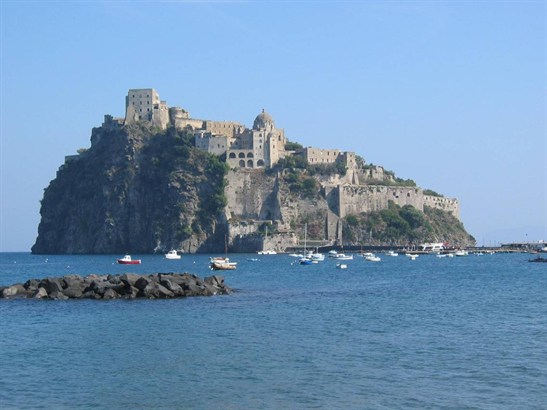Castles and stately homes: Ischia
 Ischia and Procida came under the control of the d’Avalos family at the beginning of the sixteenth century. Ferdinand the Catholic conceded the island of Ischia to Costanza d’AvalosThe daughter of Innico I d’Avalos, Costanza (1460-1541) was the wife of Federico del Balzo, the Prince of Altamura, the Duke of Venosa and brother of Queen Isabella of Naples. After the death of her consort, she reached her brother Innico II in Ischia, the government of which she obtained from the Spanish and where she established her court. Charles V granted her the area corresponding to the present town of Pescara, of which the d’Avalos held the marquisade. for life: it became the main residence of the family for almost two centuries. Along with its military and defensive role, it served as the seat of a noble court and established itself as the favourite residence of “great captains”, governors, beautiful women, artists and courtiers. Vittoria Colonna, around whom a true humanist coterie was formed, played a central role there. It was in Ischia that Vittoria had married Fernando (Ferrante) Francesco d’Avalos, who was then the victor of the battle of PaviaFought on 24 February 1525, the Battle of Pavia marked the final defeat of the French king Francis I (who was taken prisoner) in the wars for domination of Italy. The victory of the Habsburg army, on the contrary, confirmed Spanish rule in the Peninsula. (1525), where he captured Francis I, King of France. Ferrante died from injuries sustained in the battle. Vittoria Colonna then decided to live permanently in the castle of Ischia, surrounding herself with artists and poets, among them Sannazzaro and Michelangelo. Attacked several times by pirates, looted and destroyed, the island underwent a period of deep crisis in the second half of the sixteenth century. From the beautiful home of the Renaissance court, the fortress was converted into a convent of Poor Clares in 1577, at the expressed wish of the wife of Muzio d’Avalos, Beatrice Quadra, who had inherited it from her husband. The island experienced a new period of importance in the last decades of the seventeenth century and especially during the War of the Spanish Succession, also thanks to the d’Avalos, under whose control it remained until 1736, when it became crown land.
Ischia and Procida came under the control of the d’Avalos family at the beginning of the sixteenth century. Ferdinand the Catholic conceded the island of Ischia to Costanza d’AvalosThe daughter of Innico I d’Avalos, Costanza (1460-1541) was the wife of Federico del Balzo, the Prince of Altamura, the Duke of Venosa and brother of Queen Isabella of Naples. After the death of her consort, she reached her brother Innico II in Ischia, the government of which she obtained from the Spanish and where she established her court. Charles V granted her the area corresponding to the present town of Pescara, of which the d’Avalos held the marquisade. for life: it became the main residence of the family for almost two centuries. Along with its military and defensive role, it served as the seat of a noble court and established itself as the favourite residence of “great captains”, governors, beautiful women, artists and courtiers. Vittoria Colonna, around whom a true humanist coterie was formed, played a central role there. It was in Ischia that Vittoria had married Fernando (Ferrante) Francesco d’Avalos, who was then the victor of the battle of PaviaFought on 24 February 1525, the Battle of Pavia marked the final defeat of the French king Francis I (who was taken prisoner) in the wars for domination of Italy. The victory of the Habsburg army, on the contrary, confirmed Spanish rule in the Peninsula. (1525), where he captured Francis I, King of France. Ferrante died from injuries sustained in the battle. Vittoria Colonna then decided to live permanently in the castle of Ischia, surrounding herself with artists and poets, among them Sannazzaro and Michelangelo. Attacked several times by pirates, looted and destroyed, the island underwent a period of deep crisis in the second half of the sixteenth century. From the beautiful home of the Renaissance court, the fortress was converted into a convent of Poor Clares in 1577, at the expressed wish of the wife of Muzio d’Avalos, Beatrice Quadra, who had inherited it from her husband. The island experienced a new period of importance in the last decades of the seventeenth century and especially during the War of the Spanish Succession, also thanks to the d’Avalos, under whose control it remained until 1736, when it became crown land.
The Aragonese Castle of Ischia, built in the fifth century B.C. by Hiero I of Syracuse on the ruins of an earlier fortification, is located on an island of volcanic origin. After a long period of neglect it was rebuilt thanks to Alfonso I of AragonAlfonso of Trastámara called the Magnanimous (1394-1458), was the Count of Barcelona and the Catalan counties, the King of Aragon, Valencia, Majorca, Sardinia, Sicily, Jerusalem, Hungary and, from 1442, King of Naples with the name of Alfonso I. After conquering the Kingdom of Naples, he established his court in the capital city of Naples, transforming it into the centerpiece of the Crown of Aragon., who connected it to the mainland by a stone bridge. With the d’Avalos, the castle became home to many artistic circles. Inside the walls are the remains of the ancient cathedral dedicated to the Assumption, built in 1301 but now destroyed, where, in 1509, the marriage of Francesco Ferrante d’Avalos and Vittoria Colonna was celebrated. Uncovered, with the exception of the chancel, the walls, part of the Baroque stucco and the Gothic crypt with frescoes of the school of Giotto remain.
